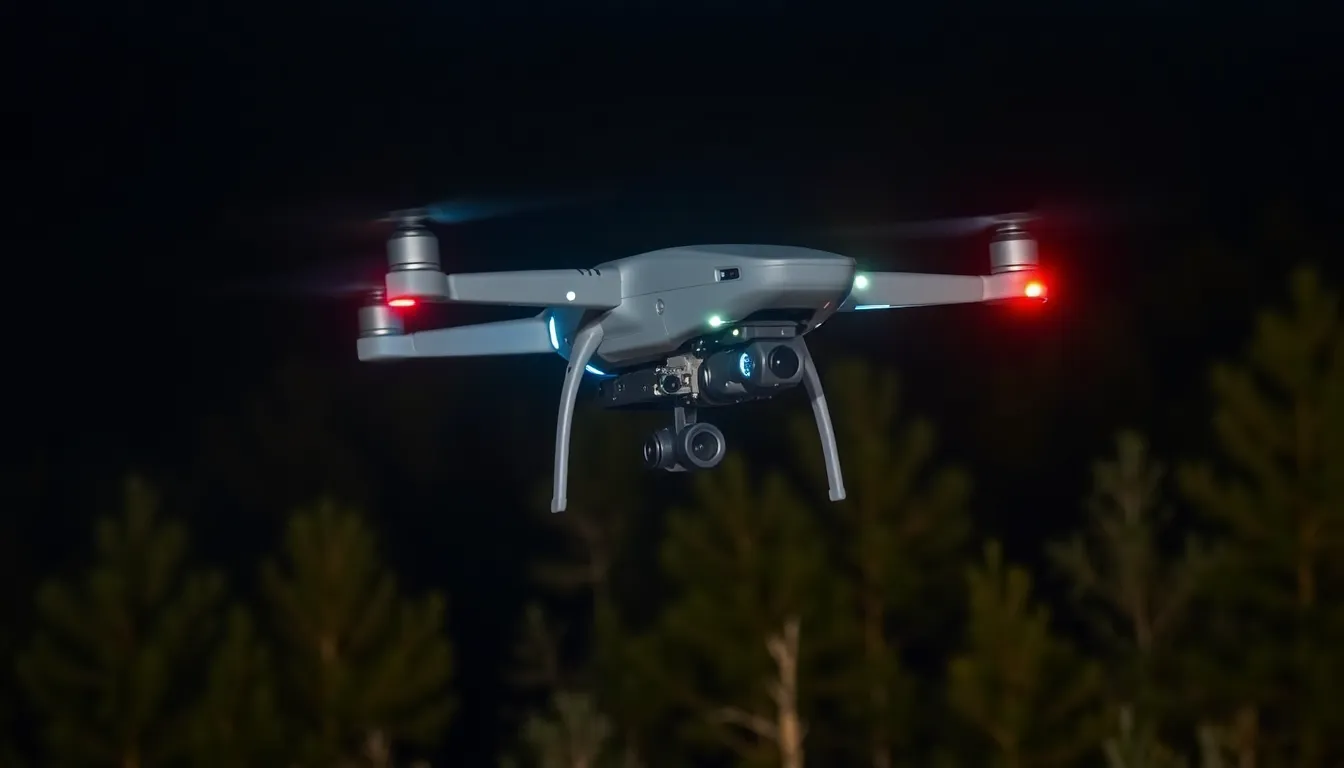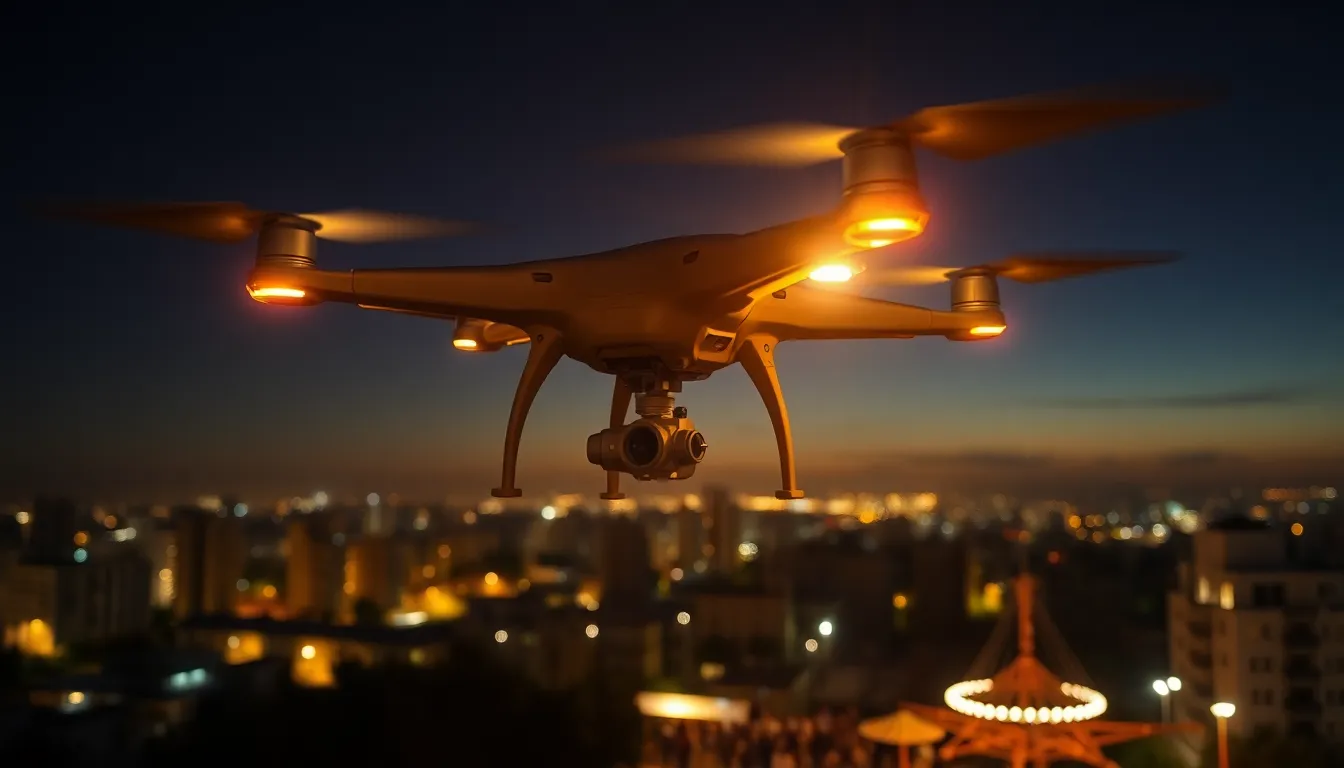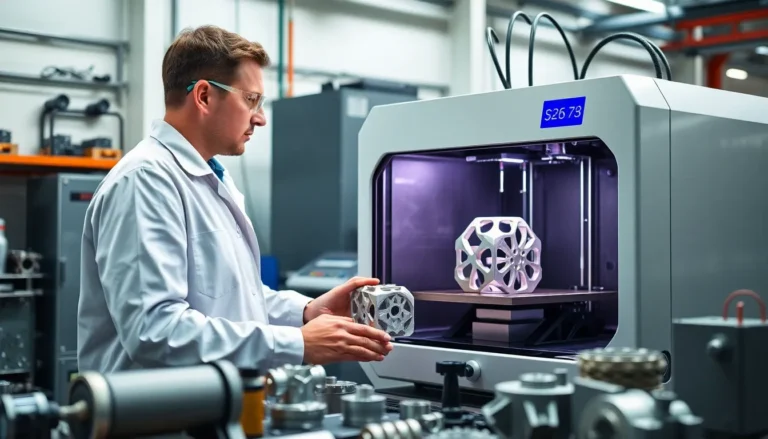As the sun dips below the horizon, a new breed of aerial surveillance takes to the skies. Government drones flying at night might sound like the plot of a sci-fi movie, but it’s a reality that’s here to stay. Picture this: tiny flying robots zipping around, equipped with high-tech cameras and sensors, all while you’re trying to enjoy a peaceful evening on your porch. It’s like having an uninvited guest who’s really into your late-night snack choices!
These drones have become essential tools for monitoring everything from natural disasters to public safety. But with their stealthy operations and buzzing presence, they raise a few eyebrows and even more questions. Are they keeping us safe or just spying on our midnight snack runs? Buckle up as we explore the night sky’s newest inhabitants and the intriguing implications of their nocturnal flights.
Table of Contents
ToggleOverview of Government Drones Flying at Night
Government drones flying at night utilize advanced technology to carry out various functions. Equipped with high-resolution cameras and sophisticated sensors, these drones monitor areas impacted by natural disasters like floods or wildfires. They play crucial roles in public safety, providing invaluable real-time data to first responders.
Operators deploy these drones for surveillance in urban environments, tracking criminal activities or monitoring large gatherings. The ability to fly undetected enhances their effectiveness, allowing for discreet observation. Agencies, such as law enforcement, use them to gather evidence without alerting suspects.
Despite their benefits, flying drones at night raises significant privacy concerns. Citizens often express worries about unauthorized surveillance and data collection. While these drones contribute to safety and emergency response efforts, the question of individual privacy persists.
Regulations govern night operations of government drones to mitigate potential abuses. Agencies must adhere to specific guidelines ensuring responsible usage and transparency. These rules aim to balance public safety with respect for civil liberties.
Innovations in drone technology continue to evolve, expanding their capabilities for nighttime operations. Advanced thermal imaging allows for effective monitoring in poor visibility conditions. As capabilities grow, discussions about ethical implications and operational transparency become increasingly important.
Efforts to educate the public about drone usage may help alleviate concerns. Citizens informed about drone functions and regulatory measures may feel more reassured about their presence. Open dialogue between government entities and the public is essential for fostering trust in these technologies.
Technical Capabilities of Drones

Government drones equipped with advanced technologies enhance their operational capabilities, especially during nighttime missions.
Night Vision Technology
Night vision technology enhances visibility in darkness. Such technology often relies on infrared cameras, which detect heat signatures. Advanced low-light sensors improve the clarity of images captured in dim conditions. Drones utilize this technology for various applications, including search and rescue operations or monitoring wildlife. Even thermal imaging allows operators to identify objects that aren’t visible to the naked eye. This capability plays a critical role in maintaining safety during nighttime missions, providing essential data to first responders and law enforcement officials.
Flight Operations in Low Light
Flight operations in low light require specialized navigation systems. Drones employ GPS and inertial navigation for accurate positioning and stability. Lighting systems integrated with these drones also ensure visibility for operators. Operators can manage flight paths and avoid obstacles effectively during nighttime missions. Stability in flight minimizes risks posed by environmental factors, such as wind or turbulence. Autonomous flight capabilities further enhance performance during low light situations, allowing drones to operate independently based on pre-programmed routes. Such advancements contribute significantly to the effectiveness of government drones in nighttime operations.
Applications of Nighttime Drone Operations
Government drones equipped for nighttime use perform vital functions across multiple sectors. These applications include surveillance and search and rescue efforts, showcasing the versatility of drone technology.
Surveillance and Security
Surveillance operations benefit from nighttime drone capabilities, enhancing security in urban environments. Equipped with thermal cameras, drones monitor large gatherings or crime scenes, enabling law enforcement to respond quickly. Advanced sensors detect unusual activities, allowing for proactive measures to ensure public safety. Additionally, drones contribute to border security by providing real-time views of extensive areas, making unauthorized crossings more detectable. Operators appreciate the drones’ ability to fly silently, reducing disturbances while gathering critical data.
Search and Rescue Missions
Search and rescue missions rely heavily on drones during nighttime operations. Drone technology is crucial for locating missing individuals in challenging terrains. Utilizing thermal imaging, these drones identify heat signatures, guiding search teams to stranded hikers or accident victims. Their ability to cover wide areas quickly enhances the efficiency of search efforts. In emergencies, operators deploy drones to assess damage in disaster-stricken locations, ensuring that responders act effectively. With integrated communication tools, information sharing became seamless, improving coordination among first responders during rescue missions.
Ethical Considerations
Government drones flying at night raise significant ethical questions. Privacy concerns dominate discussions, with citizens worried about unauthorized surveillance. Trust in government operations often hinges on transparency and accountability. Balancing public safety with individual rights requires careful navigation.
Regulations become crucial in defining the extent of drone surveillance. They guide how drones can operate at night, outlining permissible activities and ensuring protective measures. Without clear regulations, citizens might perceive these drones as invasive, fostering distrust.
Surveillance capabilities augment privacy worries. Drones equipped with advanced cameras can potentially capture personal activities, intensifying feelings of being watched. Citizens expect responsible usage to mitigate these concerns while ensuring safety and security.
Education plays a vital role in addressing these ethical dilemmas. Informing the public about drone functions and regulatory measures helps mitigate fears. Awareness can lead to understanding, fostering a more trusting relationship between government entities and citizens.
Proactive public engagement includes open discussions about drone applications. Community forums and informational campaigns allow citizens to express concerns and ask questions. These dialogues contribute to a more balanced perspective on the role of drones in society.
As technology evolves, so do ethical considerations. Authorities must adapt regulations to keep pace with advancements in drone capabilities. Continuous evaluation of the ethics surrounding nighttime operations ensures that safety does not come at the expense of privacy.
Drones offer invaluable services, but ethical frameworks must guide their deployment. Ongoing assessments will strengthen public confidence, aligning governmental actions with community values. Addressing ethical considerations directly influences public perception and acceptance of government drone initiatives.
Future Developments in Drone Technology
Emerging technologies are set to revolutionize government drones, particularly for nighttime operations. Enhanced thermal imaging capabilities offer significant improvements in detecting heat signatures, essential for applications like search and rescue missions. Advanced artificial intelligence algorithms optimize flight paths and enhance real-time data analysis, allowing for faster decision-making during critical incidents.
Innovations in battery technology promise to extend flight durations, enabling drones to cover larger areas during nighttime missions. Increased battery life supports longer surveillance operations or extensive search and rescue efforts without recharging. As drones become more autonomous, their ability to operate independently in low-light conditions increases efficiency and safety.
Potential advancements in communication systems could facilitate direct interaction between drones and first responders, ensuring seamless data sharing during emergencies. This integration enhances situational awareness, allowing for quicker responses to critical situations. Enhanced GPS and inertial navigation systems improve positioning accuracy, making nighttime flights safer and more reliable.
Privacy regulations are likely to evolve alongside these technological advancements, establishing clear guidelines for drone usage. Implementing stricter transparency measures may help alleviate public concerns about surveillance and data collection. Education remains crucial, enabling citizens to understand advancements and addressing ethical implications surrounding drone technology.
Future developments show promise in addressing these concerns while maximizing the benefits of government drones. As technology continues to evolve, balancing public safety and individual privacy will remain paramount. In sum, the direction of drone advancements suggests a future where nighttime operations become increasingly efficient and responsible.
Government drones flying at night represent a significant advancement in technology and public safety. Their ability to monitor and respond to emergencies enhances the effectiveness of first responders and law enforcement. However, this innovation comes with pressing concerns about privacy and surveillance.
As regulations evolve to address these issues, transparency and public education will play crucial roles in building trust. The future of nighttime drone operations hinges on balancing the benefits of enhanced safety with the need for individual privacy rights. Ongoing dialogue between the government and citizens will be essential in navigating these complexities, ensuring that the use of drones serves the public good without infringing on personal freedoms.




